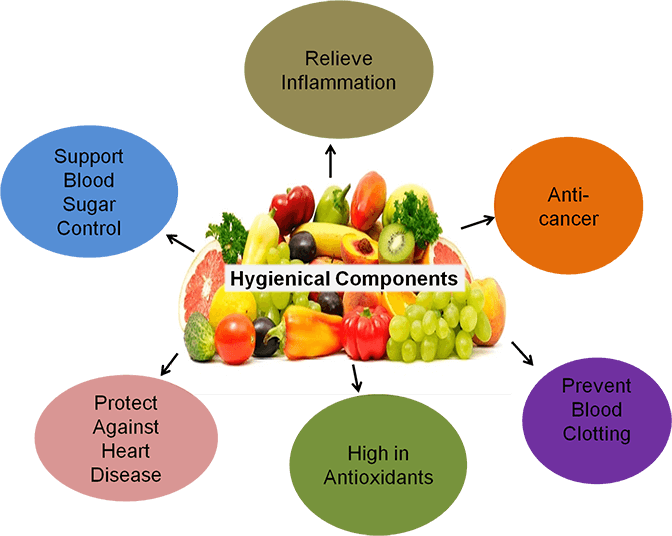Many foods, especially fresh fruits and vegetables, contain various secondary metabolic products which have hygienical functions for humans. These hygienical components include polyphenols, saponins, terpenes, carotenoids, essential oils, etc.. They have been shown to have a wide range of biological and pharmacological activities such as antioxidant, anti-inflammatory, anti-cancer, and prevention of other diseases.
 Figure 1. Benefits of hygienical components in foods.
Figure 1. Benefits of hygienical components in foods.
Lifeasible, as a world leader in food testing, provides comprehensive support for a full spectrum of hygienical components, which include, but not limited to:
- Polyphenols: Polyphenols are a category of chemicals that naturally occur in plants. There are more than 500 unique polyphenols and can be further categorized into the following groups:
- Flavonoids: Flavonoids are widely distributed in plants fulfilling many functions. They are considered as health promoting and disease preventing dietary supplements. Preliminary studies indicate that flavonoids may pose effects of antioxidant, anti-inflammatory, antibacterial, antiviral, anti-cancer, anti-cardiovascular disease, etc.. Flavonoids include anthocyanidins, flavones, flavones, flavanones, flavanonols, and isoflavonoids.
- Phenolic acids: Phenolic acids are defined chemically as carboxylic acids derived from either benzoic or cinnamic acid skeletons. There are two important naturally occurring types: hydroxybenzoic acids (found in tea) and hydroxycinnamic acids (found in cinnamon, coffee, blueberries, kiwifruits, plums, apples, and cherries). Being antioxidants, phenolic acids can help human strengthen the immune system and fight off diseases and infections.
- Stilbenes: Stilbenes are natural compounds found in some types of plants found in peanuts, blueberries, cranberries, red wine, and grapes. Resveratrol and pterostilbene are quite well known and have been shown to act as antioxidant and anti-inflammatory agents in some laboratory animals.
- Lignans: Lignans are found in seeds like flax, legumes, cereals, grains, fruits, algae, and certain vegetables. They have antioxidant activities and can help reduce the risk of hormone-associated cancers (breast, uterine, ovarian, and prostate).
- Terpenes: Terpenes are a large and diverse class of organic compounds found in a variety of plants, particularly conifers, and even some insects. The common types are as follows:
- Myrcene: Myrcene is commonly found in mangoes, hops, thyme, cannabis, and lemongrass. myrcene has anti-inflammatory, antibiotic, antimutagenic, and analgesic properties in therapeutic.
- Limonene: Limonene is known for its anti-inflammatory, powerful antifungal, antibacterial, and anti-depressant properties. It can also help alleviate bronchitis and heartburn, as well as enhance the absorption ability of other terpenes. Limonene is found in the rinds of citrus fruits, rosemary, peppermint, juniper, and pine needles.
- Terpinolene: Terpinolene is shown to have slightly sedative, antioxidant, anti-cancer, and antibacterial effects.
- Caryophyllene and beta-Caryophyllene: They have been found to relieve pain, symptoms of anxiety and depression, and oxidation.
- Pinene: Pinene is commonly found in pine trees, conifer trees, citrus peels, and turpentine trees. Pinene is a powerful bronchodilator, an anti-inflammatory, and an antiseptic.
- Linalool: Linalool is commonly found in lavender, mint, cinnamon, rosewood, citrus, birch trees, and laurels. It is known for its pleasant fragrance and often used in perfumes. Linalool is also used as an anti-inflammatory, anti-anxiety, antidepressant, anti-convulsant, and sedative. Linalool is also used to relieve seizure symptoms and provide relief to those suffering from psychosis.
- Essential oils: Essential oils refer to the predominantly volatile and odorous fractions isolated by some physical process from vegetable materials. They are often used for flavoring food and drink and in perfumes, cosmetics, soaps, and other products. Essential oils are also used for aromatherapy, which may be useful to induce relaxation. The common types of essential oil include garlic oil,eucalyptus oil,lavender oil,rose oil, etc..
- Saponins: Saponins are glucosides with foaming characteristics and can be found in most vegetables, beans, and herbs. Saponins have many health benefits on blood cholesterol levels, cancer, bone health, and stimulation of the immune system. Some plant saponins, for example those from oat and spinach, may enhance nutrient absorption and aid in animal digestion. There are more than eleven classes of saponins including dammaranes, tirucallanes, lupanes, hopanes, oleananes, taraxasteranes, ursanes, cycloartanes, lanostanes, cucurbitanes, and steroids.
- Carotenoids: Carotenoids are pigments in plants, algae, and photosynthetic bacteria. Carotenoids are classified into two main groups: xanthophylls and carotenes. Both types of carotenoids have antioxidant properties which can protect humans from disease and enhance your immune system. Some carotenoids can be converted into vitamin A, an essential component for growth, immune system function, and eye health. The provitamin A carotenoids include alpha-carotene, beta carotene, and beta-cryptoxanthin. Non-provitamin A carotenoids have lutein, zeaxanthin, and lycopene.
Our professionals and technicians work as a team to provide you with a fast and complete service using various techniques, such as high-performance liquid chromatography (HPLC) and gas chromatography (GC). These chromatographic technologies provide various solutions for separation, including electron ionization (EI), electrospray ionization (ESI), ion chromatography (IC), dielectric barrier discharge ionization (DBDI), and for detection, such as electrical conductivity, suppressed conductivity, UV/Vis, and mass spectrometry (MS). Lifeasible can also provide personalized services to meet your specific requirements. You are always welcome to contact us for any questions you may have on analysis of hygienical components.
Our products/services are For Research Use Only. Not For Clinical Use!
 Figure 1. Benefits of hygienical components in foods.
Figure 1. Benefits of hygienical components in foods.